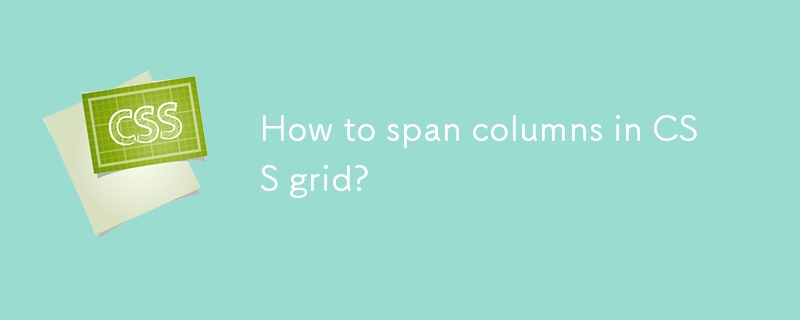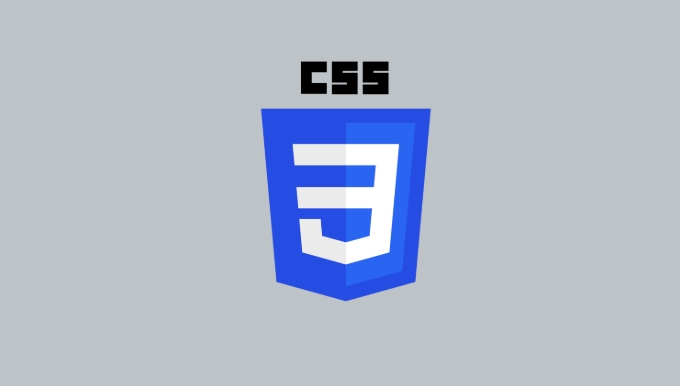To use CSS Grid across columns, you need to control the number of columns across domains through grid-column attribute; 1. Use grid-column: 1 / 3 to represent the starting line 1 to the third line, span 2; 2. Use grid-column: 1 / span 2 to achieve the same effect and clarify the span; 3. Use grid-column: span 3 to automatically place the project and span 3 columns; 4. Use grid-column-start and grid-column-end to set the start and end lines respectively, such as grid-column-start: 2; grid-column-end: span 3; to represent the span 3 columns starting from the second line; 5. Use grid-column: 1 / -1 can span from the first column line to the last line, achieving a full-width layout. This method combines auto-fit or auto-fill for responsive design. The column lines start from 1 and support negative numbers. -1 represents the last line. After mastering the line-based thinking, the layout is more flexible and powerful.

To span columns in CSS Grid, you use the grid-column property (or its shorthand parts grid-column-start and grid-column-end ) to control how many columns an item should span across.

Here's how it works:
1. Using grid-column: start / end
You define where the column starts and where it ends (exclusive of the end line).

.item {
grid-column: 1 / 3;
}This means the item starts at column line 1 and spans to column line 3 — so it takes up 2 columns .
You can also use span to make it clearer:

.item {
grid-column: 1 / span 2;
}This does the same thing: starts at line 1 and spans 2 columns .
2. Shortand with span anywhere
You don't have to specify the start — you can let the grid auto-place and then say "span 3 columns":
.item {
grid-column: span 3;
}This lets the item be placed automatically but take up 3 columns.
3. Using separate properties
You can also use the longhand versions:
.item {
grid-column-start: 2;
grid-column-end: 5;
}This spans from line 2 to line 5 (covers 3 columns).
Or with span :
.item {
grid-column-start: 2;
grid-column-end: span 3; /* ends 3 columns after start */
}Example layout
Say you have a 3-column grid:
.container {
display: grid;
grid-template-columns: 1fr 1fr 1fr;
gap: 10px;
}
.full-width {
grid-column: 1 / -1; /* spans from first to last line */
} Here, .full-width spans all columns — from line 1 to the last line (which is -1 ).
Key tips:
- Column lines are numbered starting from 1 (not 0).
- You can use negative numbers:
-1is the last line. - Use
spanwhen you care more about width than exact placement. - Works great with responsive layouts when combined with
auto-fitorauto-fill.
So in short:
-
grid-column: 1 / 3;→ spans 2 columns -
grid-column: span 2;→ spans 2 columns, auto-placed -
grid-column: 2 / span 3;→ starts at line 2, spans 3 -
grid-column: 1 / -1;→ spans full width
That's basically it — flexible and powerful once you get the line-based thinking.
The above is the detailed content of How to span columns in CSS grid?. For more information, please follow other related articles on the PHP Chinese website!

Hot AI Tools

Undress AI Tool
Undress images for free

Undresser.AI Undress
AI-powered app for creating realistic nude photos

AI Clothes Remover
Online AI tool for removing clothes from photos.

Clothoff.io
AI clothes remover

Video Face Swap
Swap faces in any video effortlessly with our completely free AI face swap tool!

Hot Article

Hot Tools

Notepad++7.3.1
Easy-to-use and free code editor

SublimeText3 Chinese version
Chinese version, very easy to use

Zend Studio 13.0.1
Powerful PHP integrated development environment

Dreamweaver CS6
Visual web development tools

SublimeText3 Mac version
God-level code editing software (SublimeText3)
 CSS Grid vs Flexbox: code comparison
Jun 01, 2025 am 12:03 AM
CSS Grid vs Flexbox: code comparison
Jun 01, 2025 am 12:03 AM
CSSGrid and Flexbox can be used in combination, but Grid is more suitable for two-dimensional layouts, while Flexbox is good at one-dimensional layouts. 1.Grid defines grid structure through grid-template-rows and grid-template-columns, which is suitable for complex two-dimensional layouts. 2. Flexbox controls direction and space allocation through flex-direction and flex attributes, suitable for one-dimensional layout and simple responsive design. 3. In terms of performance, Flexbox is suitable for simple layouts, and Grid is suitable for complex layouts, but may affect browser rendering performance. 4. Compatibility, Flexbox supports more extensively, Grid in modern browsers
 How can CSS Grid's minmax() function be used to create flexible grid tracks?
Jun 07, 2025 am 12:12 AM
How can CSS Grid's minmax() function be used to create flexible grid tracks?
Jun 07, 2025 am 12:12 AM
CSS's minmax() function is used to define the minimum and maximum size range of grid tracks, thereby improving layout flexibility. Its core function is to let the developer specify a size interval, such as minmax (200px, 1fr) means that the column width is at least 200px and can be stretched to 1fr at most. Common uses include responsive card layout, automatic column width adjustment of data tables, and balanced blank areas. Commonly used combinations include minmax (200px, 1fr), minmax (min-content,max-content), minmax (150px, 300px) and minmax (auto, 1fr). Notes include avoiding setting too high minimum values ??and testing different screens
 What are the advantages of using CSS Grid for complex two-dimensional page layouts?
Jun 12, 2025 am 10:28 AM
What are the advantages of using CSS Grid for complex two-dimensional page layouts?
Jun 12, 2025 am 10:28 AM
CSSGridisapowerfultoolforcreatingcomplextwo-dimensionallayoutsbyofferingcontroloverbothrowsandcolumns.1.Itallowsexplicitdefinitionofrowsandcolumnswithflexiblesizingusingfeatureslikegrid-template-columns:repeat(auto-fit,minmax(200px,1fr))forresponsive
 Can you nest a Flexbox container inside a CSS Grid item?
Jun 22, 2025 am 12:40 AM
Can you nest a Flexbox container inside a CSS Grid item?
Jun 22, 2025 am 12:40 AM
Yes, you can use Flexbox in CSSGrid items. The specific approach is to first divide the page structure with Grid and set the subcontainer into a Grid cell as a Flex container to achieve more fine alignment and arrangement; for example, nest a div with display:flex style in HTML; the benefits of doing this include hierarchical layout, easier responsive design, and more friendly component development; it is necessary to note that the display attribute only affects direct child elements, avoids excessive nesting, and considers the compatibility issues of old browsers.
 What are fr units in CSS Grid?
Jun 22, 2025 am 12:46 AM
What are fr units in CSS Grid?
Jun 22, 2025 am 12:46 AM
ThefrunitinCSSGriddistributesavailablespaceproportionally.1.Itworksbydividingspacebasedonthesumoffrvalues,e.g.,1fr2frgivesone-thirdandtwo-thirds.2.Itenablesflexiblelayouts,avoidsmanualcalculations,andsupportsresponsivedesign.3.Commonusesincludeequal-
 What is CSS Grid Layout?
Jun 23, 2025 am 12:13 AM
What is CSS Grid Layout?
Jun 23, 2025 am 12:13 AM
CSSGrid is a two-dimensional web layout tool that allows developers to accurately control the position and size of page elements by defining rows and columns. Unlike Flexbox, it can handle rows and columns simultaneously, suitable for building complex structures. To use Grid, you must first set the container to display:grid, and define the row and column size through 1.grid-template-columns and 2.grid-template-rows, set the spacing, and 4.grid-template-areas named area to improve readability. Its typical application scenarios include responsive layouts, dashboard interfaces, and picture galleries. Practical tips include: 5. Use grid-column/g
 How to place items on a CSS grid using line numbers?
Jun 25, 2025 am 12:36 AM
How to place items on a CSS grid using line numbers?
Jun 25, 2025 am 12:36 AM
ToplaceitemsonaCSSGridusinglinenumbers,youspecifythestartandendlinesforrowsandcolumns.1)Gridlinesareautomaticallynumberedstartingfrom1atthetop-leftcorner,withverticallinesseparatingcolumnsandhorizontallinesseparatingrows.2)Usegrid-columnandgrid-rowto
 How to use CSS Grid and Flexbox together tutorial
Jun 27, 2025 am 12:40 AM
How to use CSS Grid and Flexbox together tutorial
Jun 27, 2025 am 12:40 AM
CSSGrid and Flexbox each have their own expertise, and the best results are used together. Grid is a two-dimensional layout that is suitable for the overall page structure, such as the arrangement of the header, sidebar, main content area, and footer; Flexbox is a one-dimensional layout that is more suitable for internal arrangement of components, such as navigation bar, button group, card list, etc. For example, use Grid in the middle of the three-column layout and then block up and down, and use Flexbox to automatically align several buttons in a row. The actual combination method is: the outer container uses display:grid to define the overall framework, and the child elements are arranged using display:flex in each area. Common structures include the entire page using Grid to divide blocks, and the navigation bar, button group and card list are aligned with Flexbox. Note






